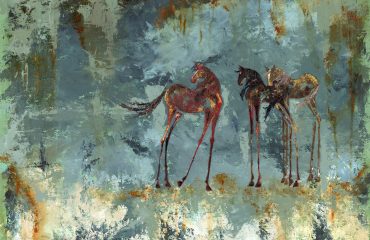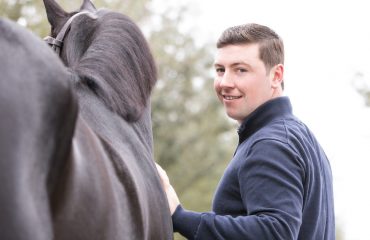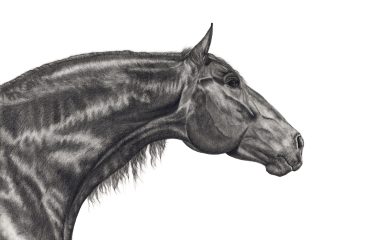Put the best mare to the best stallion and hope for the best sums up the gamble of breeding. The hopes and dreams that arise during 11 months of gestation escalate when that spindly, splay-legged foal enters the world. To fulfill his or her destiny as a superstar, that foal needs to be genetically loaded. The high tech of reproductive science and genomics isn’t everyone’s cup of tea, but suppose you have a chance to resuscitate a great bloodline, one that has pretty much disappeared: would you consider cloning?
A number of horsemen have already answered yes. There are clones of cutting and reining horses, jumpers, and pony hunters: Rainbow Connection, Sapphire (the gelding owned and ridden to 2003 Pan Am individual gold by Mark Watring) and Gem Twist, to name just three. Also, some people of means have cloned a beloved equine for personal enjoyment. From the moment these “twins” are born they display familiar characteristics and behaviors, many without ever meeting their “original.” Clones are opening doors to new knowledge about learned and inherited behaviors.

Rainbow Connection didn't have time for babies during her 20 year show career. Dr. Betsee Parker decided to clone and got Rainbow Reflection, but the trial and error of SCNT resulted in a "litter" of three more Rainbows, shown here with Oliver Brown, their trainer and handler. Photo by Janet Hitchen
Yet, for all that clones are replicas, they are unique. Some people are thrilled, others are offended or apprehensive, but one thing is certain: it won’t be long before cloned sport horses and ponies enter competitive arenas.
The Birth of Equine Cloning
For hundreds of years, horticulture has utilized cloning or asexual propagation, but reproductive cloning, aka Somatic Cell Nuclear Transfer (SCNT) is relatively new. SCNT celebrated its first success in July 1996 when the Finn-Dorset ewe called Dolly was born in Scotland. In early 2003 scientists in Idaho cloned a mule. Later that year Cesare Galli, Director of the Laboratory of Reproductive Technology and his team of colleagues in Cremona, Italy made history when they created an embryo from the combination of an empty equine egg with a skin cell from a donor mare and implanted it. The resulting Haflinger foal, named Prometea, was the first successful horse clone: she was also the first to be cloned from and then carried by the genetic donor. DNA testing verified that the foal was the exact genetic twin of the donor mare. In 2008, after being artificially inseminated by a Haflinger stallion, Prometea gave birth naturally to a healthy colt.
The first cloned horse in North America and only the third in the world, produced by Texas A&M University College of Veterinary Medicine and Biomedical Sciences in 2005, produced findings that contributed greatly to the success of equine clones for commercial purposes. Until 2006 all cloning took place as experiments by scientists: that year, however, ViaGen, with then partner Encore Genetics, produced the first commercially cloned foal: Royal Blue Boon Too, the genetic twin of Royal Blue Boon (1980-2011), registered Quarter Horse and cutting horse mare with career earnings of more than $380,000.
The Science
The SCNT process begins with a single mature unfertilized egg whose nucleus has been removed and discarded; it is replaced by an adult somatic cell from the donor animal. [A somatic cell, which contains both sets of genes from the donor’s original sire and dam, is any body cell, but not an egg or sperm cell.] The resulting embryos are cultured and monitored for normal cell division and growth. When ready, they are transferred to carefully chosen host mares who, under veterinary supervision, carry the developing fetuses to term.
The process involves intense trial-and-error. Hundreds of cells might be cultured to create embryos, yet many won’t make it past the first week and those that make it to the transfer stage don’t always survive in utero. The science of cloning continues to evolve by leaps and bounds, but the jury is still out. Cloning has its enthusiasts but also its neigh-sayers. A cloned gelding, of course, is born as a colt with full reproductive capabilities and fillies can grow up to be broodmares, so it is a means to perpetuate bloodlines that otherwise might be lost.
Clones In Competition
Breeding sport horses boils down to producing equine athletes with the scope, range, movement, talent and brain for their discipline or sport: brilliance is a bonus. The cost of a clone is about $165,000 (with discounts for any additional live foals born as a result of the SCNT process): that’s a ballpark going price for a horse capable of high performance level competition. The variables – nutrition, nurturing, environment, trainer, rider and the element of luck – make each foal a gamble.
Right now, there are laws in place to prohibit the registration of clones with the Jockey Club and with the Quarter Horse Association – no matter what the originals might have accomplished or how fancily they are bred. In fact, a 2007 ruling by the FEI (International Equestrian Federation) bans all clones and their offspring from international competition. A number of old-fashioned horsemen think that’s a bad rule, including Frank Chapot, who pointed out: “It probably could not hold up and how could anybody enforce it unless they take DNA samples? The horses may have papers, but who knows how a horse is bred? Those papers might be good – or not.”
The live cover stipulation for Thoroughbreds registered with the Jockey Club makes sense in many ways. However, no one can predict what the future will bring, especially when the classic distance bloodlines of 20 and 30 years ago seem to be headed the way of the Dodo bird.
For the American Quarter Horse Association, FEI and other governing organizations banning the registration of clones and their progeny: that seems a bit rigid. Who can deny that the reining world would benefit from foals out of that great broodmare, Royal Blue Boon? As for the jumper world, you’d have to be a daggone fool to turn down the opportunity to campaign the get of a proven performer like Gem Twist via Gemini.
That a bunch of clones in competition arenas would impact adversely on the so-called level playing field is a specious argument, at best. Not every great horse is an easy ride. Not every trainer will have the tact to find the right human partner for a sensitive and quirky equine athlete. You can put a mediocre rider on a good horse and have some success, but it takes a great rider to allow any horse to blossom and fulfill its destiny.
One thing’s certain: time and performance records will tell the tale of the clones: that and the demand for their get.
-By Lauren Giannini













